Laptop Mag Verdict
A breathtaking design and innovative instant-on mode make this luxury ultraportable worth the splurge, but we wish it lasted longer unplugged.
Pros
- +
Wonderfully thin with sturdy carbon fiber chassis
- +
Can surf the Web without booting Windows
- +
Ultra-bright display
- +
Best-in-class speakers
- +
External optical drive and HDMI adapter included
- +
Good productivity performance
Cons
- -
Wonky oversized touchpad
- -
Short battery life
- -
Last-generation processor
- -
Sluggish and small SSD
- -
Runs a bit warm on left side
Why you can trust Laptop Mag
It's the notebook James Bond would carry--if Sony wasn't his corporate sponsor. Yes, the Voodoo Envy 133 is one of the most striking notebooks you'll lay eyes on. It's also one of the thinnest notebooks ever. And yet there's more to this luxury ultraportable for jet-setters (starting at $2,099; $3,299 as configured) than its one-of-a-kind design. An impressive amount of innovation is going on within the 3.4-pound carbon fiber chassis.
For starters, the instant-on OS lets users surf the Web, make Skype calls, and more without booting Windows. The Envy 133 also features an ambient light sensor for the brilliant 13-inch display, a keyboard whose backlight activates when it senses your hands, and surprisingly crisp and loud speakers. Plus, the power brick doubles as a Wi-Fi access point. However, two major drawbacks--a frustratingly erratic touchpad and woefully short battery life--might be deal breakers for some.
Design
Although it can easily be compared to the MacBook Air in thinness (0.7 inches from end to end versus the Air's 0.16 to 0.76 inches), the truth is that the Envy 133 couldn't look more different. The Envy 133 makes boxy sexy, with squared-off edges and a light but very sturdy carbon fiber chassis.
The Black Weave pattern is the default finish, which we liked with the exception of noticeable smudge marks. But if you have the means, you can splurge for one of 14 other finishes ($500 to $600), ranging from Ceramic to Monaco Yellow.
Keyboard
We appreciated that the keyboard is backlit; a built-in proximity sensor triggers it automatically. The keyboard layout is a perfect rectangle, and if you run your hand lightly over the surface it almost feels like it is one with the rest of the deck. Even the Power button is contained within the layout to preserve the Envy 133's stark minimalism.
The trade-off is that not all keys are full-size, such as the right Shift key. Initially, the keyboard felt a tad cramped, but we became acclimated within half an hour and found the key to feel nice and springy.
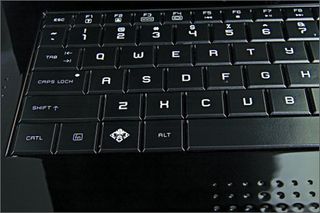
Click to enlarge
Touchpad
Normally we don't dedicate a section of a review to a notebook's touchpad, and in this case it's not good news. Sure, integrated Synaptics technology enables multi-touch gestures such as scrolling and pinching (which works for zooming in on photos, Web pages, etc.). But overall the Envy 133 is one of the most awkward touchpad implementations we've encountered.
For starters, the touchpad area is just too large. We can live with the fact that it physically blends in with the rest of the design--you can find the dimpled surface by feel--but too often we accidentally moved the cursor or minimized windows with the palm or our hand. If a finger other than your index inadvertently hits the touchpad while navigating the desktop, the cursor will stop. A few times when typing in WordPad the type size decreased or increased even though we were using only a single digit. We encountered fewer problems when we turned off both the Tap Zones feature, which enables the four corners of the touchpad to act as buttons, and Pinch gestures.
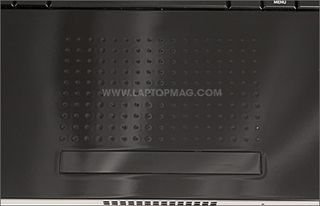
Click to enlarge
We're glad that the Envy 133 has a proximity sensor that recognizes when fingers are on the keyboard and turns off the touchpad, but we still had issues. And tweaking the size of the usable touchpad area within the settings menu (which dynamically resizes the scroll zone) barely helped. The fact that there's a single long touchpad button with no physical separation between the left and right sides doesn't help. An external mouse is a must.
Display and Audio
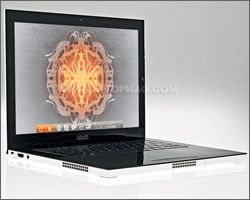
Click to enlarge
We have no complaints about the 13.3-inch LED display (1280 x 800 pixels) on the Envy 133. In fact, we love the seamless, edge-to-edge panel made of fused composite glass. The screen is oustandingly bright, so much so that you forget you're using a glossy display, which is typically prone to glare. Everything from Web pages to videos played on Hulu.com looked great.
Horizontal viewing angles are good enough for small presentations, but the screen washes out quickly as you tilt the lid down toward you. The ambient light sensor worked well, automatically dimming the display when we turned off the lights. We approve of the 1.3-megapixel webcam; our Skype test caller said they could make out a fair amount of detail in our face during a video call, even in a dimly lit room.
We were blown away by the two speakers that flank the keyboard, which benefit from Dolby Sound Room technology. When we cranked our Pandora station, the Envy 133 got quite loud with very little distortion. Skype calls were also very clear--in both directions. This is the best sounding ultraportable we've tested yet.
Ports and Included Accessories
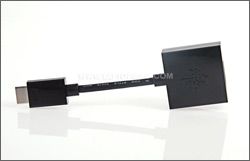
Click to enlarge
Given the Envy 133's svelte profile, Voodoo includes a generous amount of ports, including two USB ports on the right side, one of which doubles as an eSATA port (ideal for plugging in fast external hard drives) and an HDMI port on the right side for connecting to an external monitor or projector. The Envy 133 comes with a color-matched, slot-loading external DVD burner that plugs into the eSATA port (which worked well when we watched the opening scene of The Matrix), as well as a DVI-to-VGA adapter that lets you connect to an external projector or monitor without having to mess with settings.
The most interesting included accessory is the power adapter. Not only does it have its own Ethernet port, but the adapter automatically establishes a point-to-point wireless connection with the system. That's ingenious, but we would much prefer to have mobile broadband connectivity (EV-DO, HSDPA, or both) built into the notebook. At least it includes an ExpressCard slot on the right side for adding your own card, unlike the MacBook Air.

Click to enlarge
Instant-On OS
Given that the Envy 133 takes 1 minute and 10 seconds to boot into Windows, the Voodoo IOS is a welcome feature. With this technology, powered by Splashtop, you can surf the Web, make Skype calls, send and receive instant messages, and enjoy photos and videos loaded on your hard drive or a drive plugged into the USB port--all within a Linux partition (watch ourvideo hands-onto see this feature in action). Once we pressed the power button, it took only 5 seconds for a welcome screen to pop up with all of the available options. From there it took a brisk 22 seconds for the browser to load (after you configure wireless settings within the IOS menu for the first time).
Since it uses a Mozilla-based browser, the surfing experience is just as good as Firefox in Vista. Pages loaded quickly, and you can save bookmarks and set a default home page. Hulu.com videos played almost as smoothly in this Linux-based environment as in Windows. Just keep in mind that you can't download anything to the desktop in this mode, and that you can't share data between IOS and Windows. Also, we noticed that Skype calls sounded tinnier in IOS along with some crackling on the line. Oddly, you have to enter a "+" when dialing out, something you don't have to do in Vista.
The instant messaging client, powered by Pidgin, supports all of the major services (including AIM, Google Talk, MSN, and Yahoo), and we like that you can send and receive IMs while you're surfing. The music and photo players are rudimentary, and we doubt many people will use them. Shutting down took a quick 9 seconds (versus 19 for Windows), and you can either turn the Envy 133 completely off from the IOS menu or enter Vista.
Some will prefer to use Windows' sleep mode and skip Voodoo IOS, but given this system's poor battery life, this feature has even more value with the Envy 133 than with other notebooks. Unfortunately here, too, we found the touchpad to be erratic; at times the cursor would jump around.
Performance

Click to enlarge
Powered by an aging but capable 1.8-GHz Intel Core 2 Duo P7700 processor and 2GB of RAM, the Voodoo Envy 133 was pretty snappy overall, even with several application windows open. We were unable to run our usual PCMark Vantage test (which measures Vista application performance) but we were generally pleased with this ultraportable's ability to handle productivity tasks and media playback at the same time. However, don't expect to play high-definition content. When we attempted to watch a high-definition episode of The Office purchased from iTunes in 720p, the video frequently stuttered.
All but casual gaming is off the table, too, as evidenced by the Envy 133's anemic 3DMark03 and 3DMark06 scores of 1025 and 477, respectively (the latter score is just over half that of the category average). Unlike other recent ultraportables, such as theLenovo ThinkPad X200, the Envy 133 doesn't use Intel's latest Centrino 2 graphics chipset. We did enjoy smooth performance when playing Marble Blast Online, a 3D marble racing game powered by the InstantAction service.
During testing the Envy 133 became a little warm on the left side near the fan, and the fan noise was noticeable but not too distracting.
Mediocre SSD

Click to enlarge
The 64GB Samsung-made solid state drive didn't impress. The Envy 133 took 6 minutes and 3 seconds to complete the LAPTOP Transfer Test (copying a 4.97GB folder of mixed media)--a data rate of 14.0 MBps. That pales in comparison to the SSDs inside the Lenovo ThinkPad X301 (32.4 MBps) and VAIO TT (18.9 MBps). Then again, the Envy 133 beats out traditional hard drives, including the 120GB, 5,400-rpm model in the HP Compaq 2530p (12.1 MBps).
Furthermore, 64GB is not a lot of storage. After installing a handful of applications, including Skype, Adobe Premiere Elements, iTunes, and ooVoo (for video calls), we had only 7.62GB of 59.6GB of usable space left. An 80GB, 4,200-rpm hard drive is also available for this machine, but that's not much better. We hope Voodoo soon either offers a faster Intel-made 80GB SSD or doubles the storage capacity to 128GB for this price.
Wireless and Battery Life
Other than the touchpad, the Envy 133's short battery life is its biggest weakness. The system lasted a mere 2 hours and 32 minutes when running the LAPTOP Battery Test (continuous Web surfing over Wi-Fi). That runtime is about 3 hours less than the category average, and about an hour shorter thanLenovo's ThinkPad X301managed. Worse, there is no extra-capacity battery available, although at least the included three-cell battery is user-replaceable (unlike the MacBook Air).
On the plus side, we enjoyed strong Wi-Fi speed and range with the Envy 133's 802.11n adapter. We saw 20.1 Mbps of throughput at 15 feet from our access and a still-strong 20.0 Mbps from 50 feet, much better than the category averages of 17.8 and 14.9 Mbps. Bluetooth is also included but, as noted above, not built-in mobile broadband. You'll have to plug a modem into the ExpressCard slot.
Software and Warranty
Voodoo makes the smart assumption that if the Envy 133 is seen in public, someone will likely want to steal it. That's why the system comes with CompuTrace LoJack for Laptops, which can help track down your system. AVG Anti-Virus is also preloaded to protect your notebook, and Voodoo includes a copy of Microsoft Office Pro 2007 at this price. Otherwise, the Envy 133 is delightfully free of software, which is smart given the minimal storage space. If you're looking for a fingerprint reader, TPM, facial recognition or other security features, look elsewhere.
Verdict
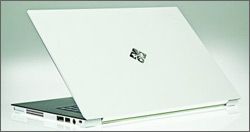
Click to enlarge
Even though it doesn't support the latest Centrino 2 technology, the Voodoo Envy 133's performance is fine for those who care about standing out in the crowd. The design is exquisite, and the instant-on OS works as advertised. Unfortunately, the unorthodox touchpad involves a learning curve (and even after that it gets in the way) and the battery life is too short for a system that's otherwise ideal for travel.
There's a lot to like about the Envy 133, but when it comes to 13-inch ultraportables, we prefer theLenovo ThinkPad X301andSony VAIO Z Series. Neither are in the same league as the Envy 133 when it comes to aesthetics, but they both offer considerably more endurance, Centrino 2 processors, and both an integrated optical drive and built-in mobile broadband.
Voodoo Envy 133 Specs
| Bluetooth | Bluetooth 2.0 |
| Brand | VooDoo |
| CPU | 1.8-GHz Intel Core 2 Duo SP7700 |
| Card Slots | ExpressCard |
| Company Website | http://www.voodoopc.com |
| Display Size | 13.3 |
| Graphics Card | Intel GMA X3100 |
| Hard Drive Size | 64GB |
| Hard Drive Type | SSD Drive |
| Native Resolution | 1280x800 |
| Operating System | MS Windows Vista Home Premium |
| Optical Drive | DVDRW |
| Optical Drive Speed | 8X |
| Ports (excluding USB) | eSATA, Microphone, Headphone, HDMI, Ethernet |
| RAM | 2GB |
| RAM Upgradable to | 2GB |
| Size | 12.7 x 9.0 x 0.7 inches |
| USB Ports | 1 |
| Video Memory | 384MB |
| Warranty/Support | One year parts-and-labor, 90-day software/Monday-Friday 9:00 a.m. to 7:00 p.m., Saturday 9:00 a.m. to 5:00 p.m. (MST) toll-free phone |
| Weight | 3.4 pounds |
| Wi-Fi | 802.11a/g/n |

